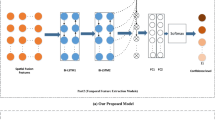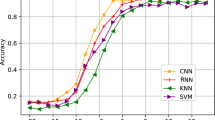Abstract
Modulation recognition is an important research area in wireless communication. It is commonly used in both military and civilian domains, such as spectrum detection and interference identification. Most existing modulation recognition algorithms have a better recognition performance at high signal noise ratio (SNR). However, when SNR decreases to − 10 dB or even lower, such as the battlefield and disaster areas and other harsh environment, the recognition rate may decrease dramatically. In order to solve this problem, a modulation recognition algorithm based on denoising bidirectional recurrent neural network is proposed. Firstly, the state memory ability of the signal reconstruction layer in the network is utilized to learn the temporal correlation of the modulated signal, the reconstruction of the received signal is completed and the noise in the modulated signal is suppressed. Then, the reconstructed signal is encoded and decoded by the feature reconstruction layer, in which the feature of reconstructed signal is compressed and reconstructed, thereby the influence of noise can be further reduced. Finally, the reconstructed features are identified and classified by the fully connected layer. Simulation results demonstrate that the proposed network can effectively suppress the noise in the signal. Compared with other existing algorithms, the proposed method has higher recognition accuracy in the low SNR environment.












Similar content being viewed by others
Data Availability
The data and material generated during and analysed during the current study are available from the corresponding author on reasonable request.
Code Availability
The code generated during the current study are available from the corresponding author on reasonable request.
References
Moser, E., Moran, M. K., Hillen, E., Li, D., & Wu, Z. (2015). Automatic modulation classification via instantaneous features. In Proceeding of 2015 National Aerospace and Electronics Conference, Dayton, OH, USA (pp. 218–223).
Kharbech, S., Dayoub, I., Zwingelstein-Colin, M., & Simon, E. P. (2018). Blind digital modulation identification for MIMO systems in railway environments with high-speed channels and impulsive noise. IEEE Transactions on Vehicular Technology, 67(8), 7370–7379.
Zhang, X., Sun, J., & Zhang, X. (2020). Automatic modulation classification based on novel feature extraction algorithms. IEEE Access, 8, 16362–16371.
Ali, A. K., & Erelebi, E. (2020). Algorithm for automatic recognition of PSK and QAM with unique classifier based on features and threshold levels. ISA Transactions, 102, 173–192.
Oshea, T. J., West, N. (2016). Radio machine learning dataset generation with gnu radio. In Proceedings of the GNU radio conference.
Shi, W., Liu, D., Cheng, X., Li, Y., & Zhao, Y. (2019). Particle swarm optimization-based deep neural network for digital modulation recognition. IEEE Access, 7, 104591–104600.
Yu, W., & Miao, L. (2019). Data driven deep learning for automatic modulation recognition in cognitive radios. IEEE Transactions on Vehicular Technology, 68(4), 4074–4077.
Shi, J., Hong, S., Cai, C., Wang, Y., Huang, H., & Gui, G. (2020). Deep learning-based automatic modulation recognition method in the presence of phase offset. IEEE Access, 8, 42841–42847.
Qu, Z., Hou, C., Hou, C., & Wang, W. (2020). Radar signal intrapulse modulation recognition based on convolutional neural network and deep Q-learning network. IEEE Access, 8, 49125–49136.
Wallayt, W., Younis, M. S., Imran, M., Shoaib, M., & Guizani, M. (2015). Automatic modulation classification for low SNR digital signal in frequency-selective fading environments. Wireless Personal Communications, 84(3), 1891–1906.
Hashim, I. A., Sadah, J. W. A., Saeed, T. R., & Ali, J. K. (2015). Recognition of QAM signals with low SNR using a combined threshold algorithm. IETE Journal of Research, 61(1), 65–71.
Li, L., Ding, Y., & Zhang, J. K. (2012). Blind detection with unique identification in two-way relay channel. IEEE Transactions on Wireless Communications, 11(7), 2640–2648.
Swami, A., & Sadler, B. M. (2000). Hierarchical digital modulation classification using cumulants. IEEE Transactions on Communications, 48(3), 416–429.
Orlic, V. D., & Dukic, M. L. (2009). Automatic modulation classification algorithm using higher-order cumulants under real-world channel conditions. IEEE Communications Letters, 13(12), 917–919.
Han, L., Xue, H., & Gao, F. (2017). Low complexity automatic modulation classification based on order statistics. In IEEE vehicular technology conference.
Funding
This work was supported by the National Natural Science Foundation of China under Grant No. 61971117, by the Natural Science Foundation of Hebei Province (Grant No. F2020501007).
Author information
Authors and Affiliations
Contributions
RD: Conceptualization, Validation, Resources, Writing—review & editing, Supervision. FL: Methodology, Validation, Resources, Writing—original draft, Supervision. LZ: Software, Validation, Resources, Writing—review & editing. YJ: Writing—review & editing, Supervision. JX: Writing—review & editing. FG: Methodology.
Corresponding authors
Ethics declarations
Conflict of interest
The authors declare that they have no known competing financial interests or personal relationships that could have appeared to influence the work reported in this paper.
Additional information
Publisher's Note
Springer Nature remains neutral with regard to jurisdictional claims in published maps and institutional affiliations.
Rights and permissions
Springer Nature or its licensor (e.g. a society or other partner) holds exclusive rights to this article under a publishing agreement with the author(s) or other rightsholder(s); author self-archiving of the accepted manuscript version of this article is solely governed by the terms of such publishing agreement and applicable law.
About this article
Cite this article
Du, R., Liu, F., Zhang, L. et al. Modulation Recognition Based on Denoising Bidirectional Recurrent Neural Network. Wireless Pers Commun 132, 2437–2455 (2023). https://doi.org/10.1007/s11277-023-10725-5
Accepted:
Published:
Issue Date:
DOI: https://doi.org/10.1007/s11277-023-10725-5




